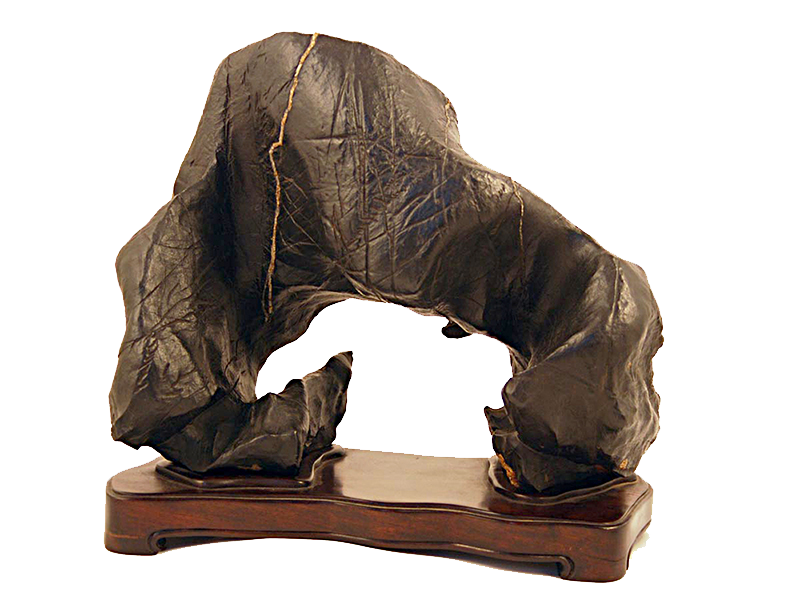Viewing Stones or Gongshi Part 1The Concept of Gonshi Explained
By Thomas S. Elias, April, 2013
Many stone collectors in North America, Europe, and other western countries have the opinion that the Chinese word “gongshi” is the correct term to use for Chinese stones, and also believe that this term is widely used today in Chinese stone appreciation circles. We came to this conclusion from reading articles and books written in English by western writers; however, as we traveled throughout China over many years attending major stone exhibitions and from consulting with Chinese language books and stone experts, we came to a different conclusion. Many different words were being used, sometimes, it depended on what part of China we were visiting.
This article examines the historical basis for the word gongshi and provides readers with the most commonly accepted word in China today for stones. This first part of this article will focus on the words gongshi and view or viewing stones. The second part, to appear in the May issue, will review sixteen of the more commonly Chinese words used for stones.
Scholars attribute the first use of the word “gongshi” to the Song dynasty poet Shu Shi (苏轼). He is believed to be the first person to raise the idea of using stones as tributes. He was referring to offering small stones to a well-respected monk. Shu Shi described small stones that were found along a river bank. He wrote that “the bigger ones are around two inches long, the smaller ones are the size of dates, chestnuts, water chestnuts and gorgon fruits. One of them looked like a tiger or leopard, it even had its own mouth, nose and eyes.” He went on to write that that he placed the stones in an ancient bronze basin and covered them with water. Shu Shi noted that when his friend Foyin, a Buddhist monk, from the Gui branch on Mountain Lu, saw the stones in the basin, he could observe the universe with his enlightened eyes. The poet stated that the monks in the mountains and commoners, who want to send gifts to Zen masters but cannot afford expensive clothes and food, should pour water into a basin with stones and used as gifts to the Zen masters. This appears to be the basis for the term respect stone or gongshi. Later, the word gongshi was expanded to include larger stones given in respect or as a tribute, but it was not a word used for all stones. Gongshi was used for a particular types of stone that were suitable to present to a highly respected person. The Qing dynasty definition of gongshi may not be the same as the earlier Song dynasty definition. That is a subject for Chinese scholars to determine.
This was not the first word used to describe unusual stones that were appreciated for their beauty, unusual shape, or other features. The word "guaishi (怪石) or unusual stone” is traced to the middle and late Eastern Zhou dynasty (about 771-256 BCE). Other early words used for stones were “wenshi (纹石) or texture stone” and “meishi (美石) or beautiful stone” that are found in the ancient Chinese work “The Classic of Mountain and Seas (山海経 ).” Most scholars’ think this is a compilation of several author’s works over time. The publication date of some parts of this work may be the early third century BCE to the first centuries CE.
Modern stone appreciation in China can be traced to the late 1970s and early 1980s. At this time, some people were using older historically based names, while others were using more modern names. Wang Jimin published an article The Categories and Connotations of View Stone’s Names in volume 6 of the 2012 Baozang magazine. His article provided interesting background information how the term “view stone” came to be more widely accepted in modern stone appreciation circles in China. He noted that sixteen different words for stones were identified in a stone appreciation conference held in Beijing in 1989. As a result of this, a panel of Chinese scholars, artists, and geologists were asked to identify the most suitable term. After consider able discussion the panel of experts agreed upon one term. In July 1990, the First Chinese View Stone Appreciation Symposium was held and the words “view stones” or “guanshanshi (观赏石)” were unveiled as the recommend words to use for ornamental stones. Since that time, the term “view stones” has been widely adopted throughout China for Chinese stones. The term ‘gongshi” is not frequently used today in China as a generic term for stones used in modern stone appreciation. In fact, it is rarely encountered and then it is used in reference to its original historical meaning. This has been verified by several stone experts we talked with in our travels in China. Future evidence for this can be seen in most of the 100+ books published in the last twenty years in China. Gongshi rarely appears in these books except as reference to their original early use as “respect stones.”



